Hard times create strong men — this adage rings true for many of the instructors and subject matter experts we have interviewed in RECOIL OFFGRID, and Raul Martinez Jr. is no exception. Growing up as a first-generation American alongside seven siblings in a low-income home, life was never easy. Compounding this, his home was located in Chicago’s Lower West Side. Inner-city gang violence was pervasive, and more than a few of Raul’s childhood friends ended up in prison or dead as a result. To break free from this vicious cycle, he joined the Army, which soon exposed him to a new type of violence in Iraq. Years later, his path came full circle as he returned home and signed up to be a patrol officer with the Chicago Police Department. Ironically, most of his days were spent dealing with the same hodgepodge of low-level gang members, drug dealers, and misguided teenagers he grew up alongside. A subsequent promotion to the undercover narcotics task force allowed him to pursue the most ruthless and well-funded echelons of Chicago’s criminal hierarchy.
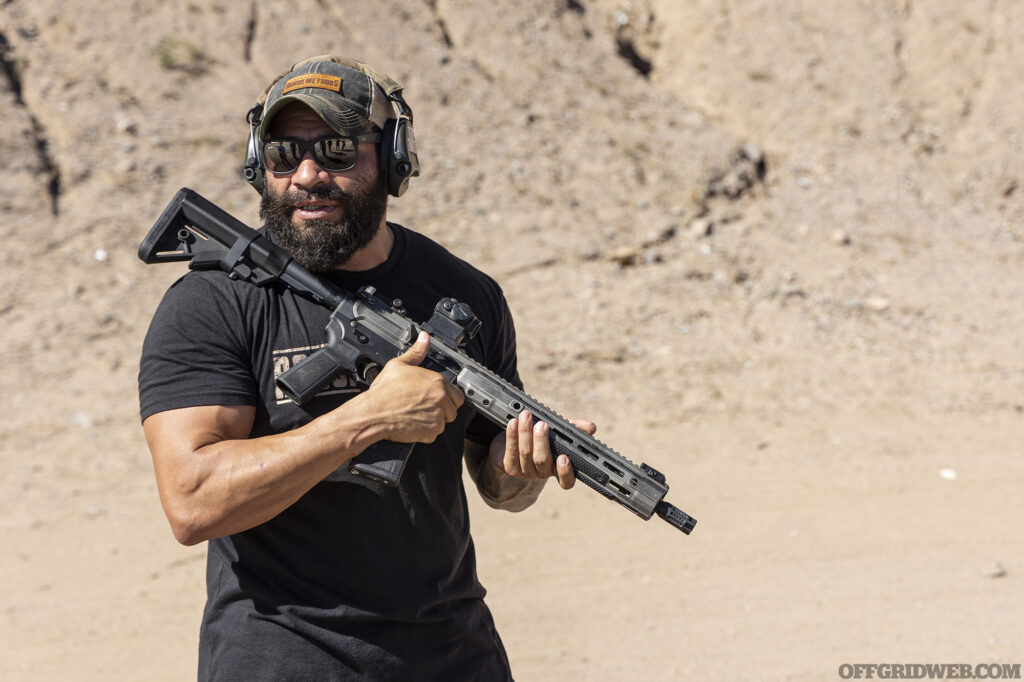
Today, Raul has blended lessons learned from his time in law enforcement, the military, and growing up in one of America’s most dangerous cities to create his own training company, Rogue Methods. His courses cover a seamless mix of hand-to-hand defensive skills, edged weapons implementation, shooting, and medical training, all within the context of a real-world, no-holds-barred fight. He has also partnered with instructors such as longtime RECOIL OFFGRID contributor Ed Calderon for joint classes. In the end, his goals are simple: to motivate everyone he meets to become better prepared for a violent altercation, and to provide them with the knowledge and experience to come out victorious.
After attending a recent Rogue Methods class, we took the opportunity to speak to Raul about his upbringing, career path, and thoughts on the self-defense training landscape.
RECOIL OFFGRID: Tell us about your upbringing. Which part of Chicago did you live in?
Raul Martinez: What can I say about Chicago that the news hasn’t already? Like most major cities, it has a highly diverse population. I was fortunate enough to be born and raised in Pilsen, a predominantly Mexican neighborhood, back in the ’80s. We were surrounded by Polish folk, Italians, Americans, and African Americans — all of us blended in community and sometimes utter chaos. Peace was often dependent on surrounding gang rivalries and their expansion for territory. Fistfights, shootouts, car chases, and a bunch of moms peeking out from their first-, second-, and third-story windows yelling for their kids to come inside, now!
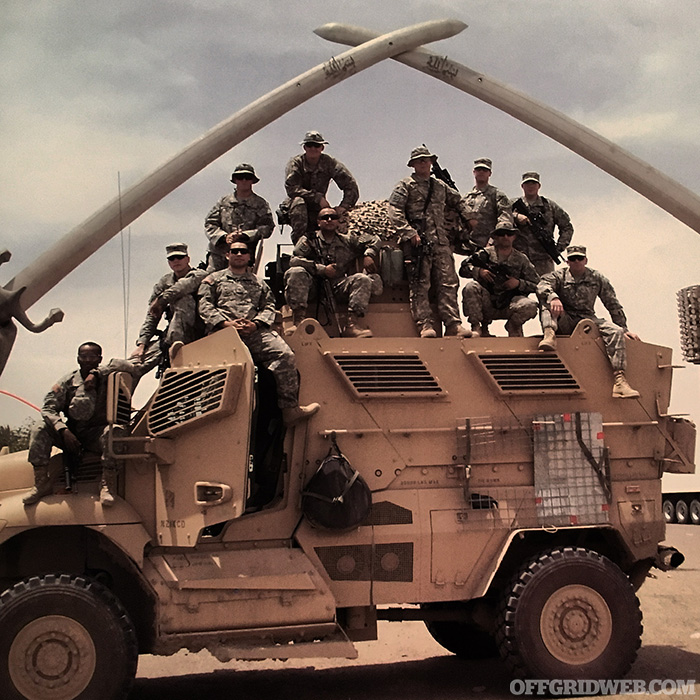
Above:The signature platoon photo while on Iraqi soil, the crossed sabers of Saddam Hussein in Baghdad, Iraq, circa 2008.
Home-cooked meals were the best, from traditional Mexican dishes to pan-fried bologna, sometimes pizza and tacos, perogies, and hotdogs. The ’80s and ’90s in Chicago were an awesome time, with and without the violence. Later, we moved to the north side of the city before I made my way to Arizona.
You mentioned one of your childhood friends ended up in prison for murder. What led you to escape that life?
RM: I have to credit my loving mother for this decision. She must have seen the writing on the wall and made the necessary moves to shift our home base north.
Being that we were lower income, the same problems laid in wait, just in a new place with new faces. From gangster rap to punk rock and all things Rage Against the Machine, then back to gangsta rap. Blending in became a skill. Thinking about it now, this eventually helped me navigate better in other countries and as a cop.
I wish nothing but the best to all my old friends. May life treat you well in all your days …
What did you do in the Army? How long were you in?
RM: Initially I wanted to be a Marine. At the time, the tattoo regulations were stiff. I went as far as getting laser removal on one neck tattoo, and it still wasn’t enough. A short walk over to the Army recruiters, and I was in — signed and ready to become a 19D Cavalry Scout. Reconnaissance was my goal. Training was fantastic, a great change of pace from city life. A few awards and leadership positions later, and I was hooked — military life was the life for me.
I deployed with the 3rd Infantry Division to Iraq from 2007 to 2009. What a wild and memorable experience that was. Foot patrols to mounted movements, single building CQB to clearing villages, small arms gunfights to Bradley fighting vehicles and their 25mm hailstorms. Meeting with local Sheikhs and training the Iraqi army and police forces. What a time to be alive. Shout out to all my old military friends, I miss you guys.
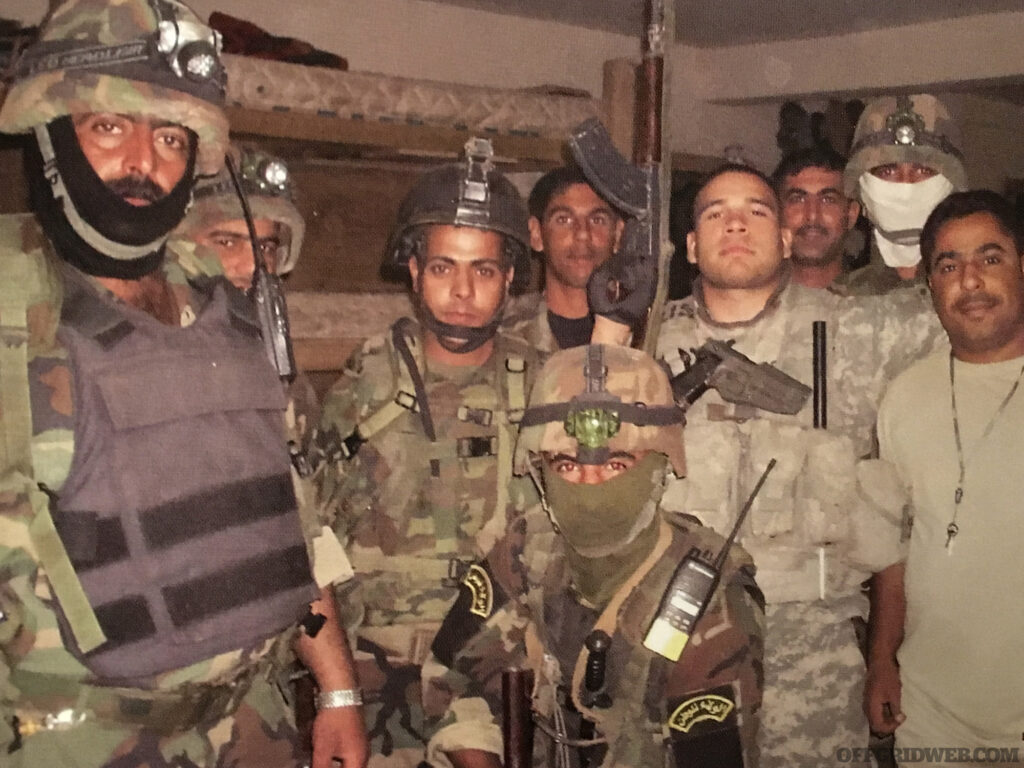
Above: With a group of trusted local fighters before one of many operations, Iraq circa 2008. These guys were hard chargers.
After all the combat jazz and incredible lessons learned, I signed on to become a Drill Sergeant. I reclassed into the Infantry as an 11B and then went to Drill school, what an honor. I wrapped up my service time of eight years in a blend of active duty and reserve time. Ending it all with a double MOS qual of 19D/11B-30X, combat deployment, a heart filled with patriotism and love for our fellow countrymen. It’s a service I will encourage my children to be a part of.
We’ve heard the tongue-in-cheek nickname Chiraq used to compare the roughest parts of Chicago to a literal war zone. How much of an exaggeration is that?
RM: What a suitable name for a city like Chicago. The nickname Chiraq is very much a matter of time and place. I say that because it does feel like a war zone every now and again, especially for those caught in the mix when gunfire rages. The violence, however, isn’t widespread across the whole of the city. It’s isolated to certain neighborhoods and areas. If violence breaks out downtown, it’s either because two rivals ran into each other and, well, what better place to show dominance than the here and now? Otherwise, it’s an organized event that is being tracked both online and by the law enforcement street teams.
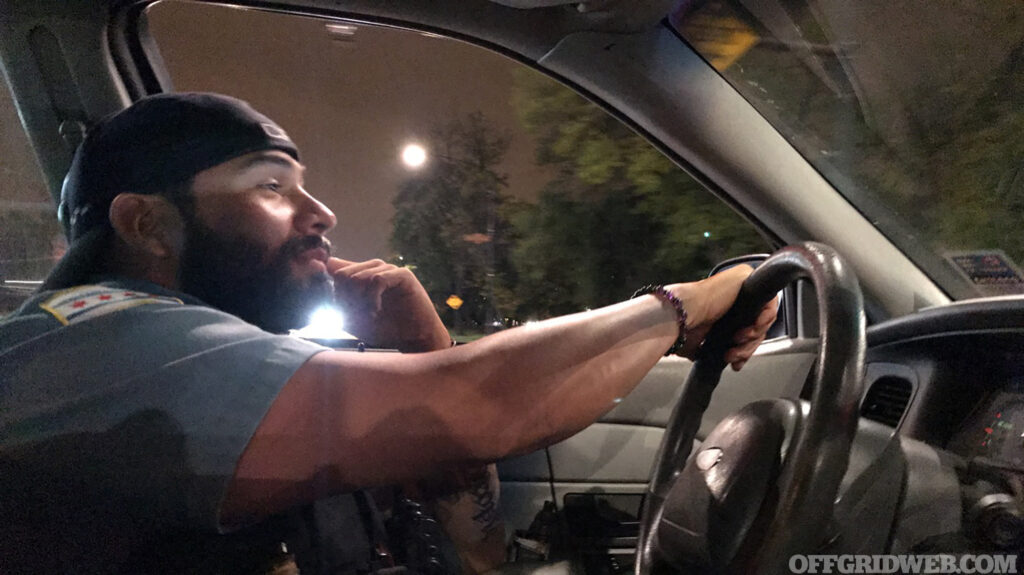
Above: Patrol work during a saturation initiative on Chicago’s South Side. Around this time, four people had been gunned down by unknown shooters who fired roughly 200 rounds of 7.62 into a vehicle. No one survived. No one was caught.
Most of the locals know the bad areas and stay away as best they can. The violence is real, yet not directed at random citizens. It’s mostly rival gangs that lack leadership and organization. Once upon a time, gang leaders had their own codes, rules, and even ethics. Most of those guys ended up in jail or dead, and all the wannabes took charge. No leadership and no direction — chaos became the new norm for the streets.
After leaving the military, did you go immediately into law enforcement? Give us an overview of your LE career path.
RM: Not immediately. I had some fun for a while as a private investigator, running surveillance jobs and tracking folks who didn’t want to be found. I enjoyed learning the PI craft thanks to a good friend in Illinois. Cheers Craig, I hope all is well.
I also spent some time contracting here in the States, mostly the coastal ones. We jumped around from the Caribbean to Australia and back again. There was a good mix of dudes in that detail — an American, a New Zealander, a South African, and an Australian. There was plenty of driving, advance planning, and surveillance work for me on that team.
In between trips, I finished the hiring process with Chicago and became a Chicago cop, something I never thought I’d be until it happened. Most officers grow up wanting to be one — not me! I still remember having to run full tilt to get away from them, being caught a few times and being held at gunpoint during traffic stops. I understood the game then and even more now.
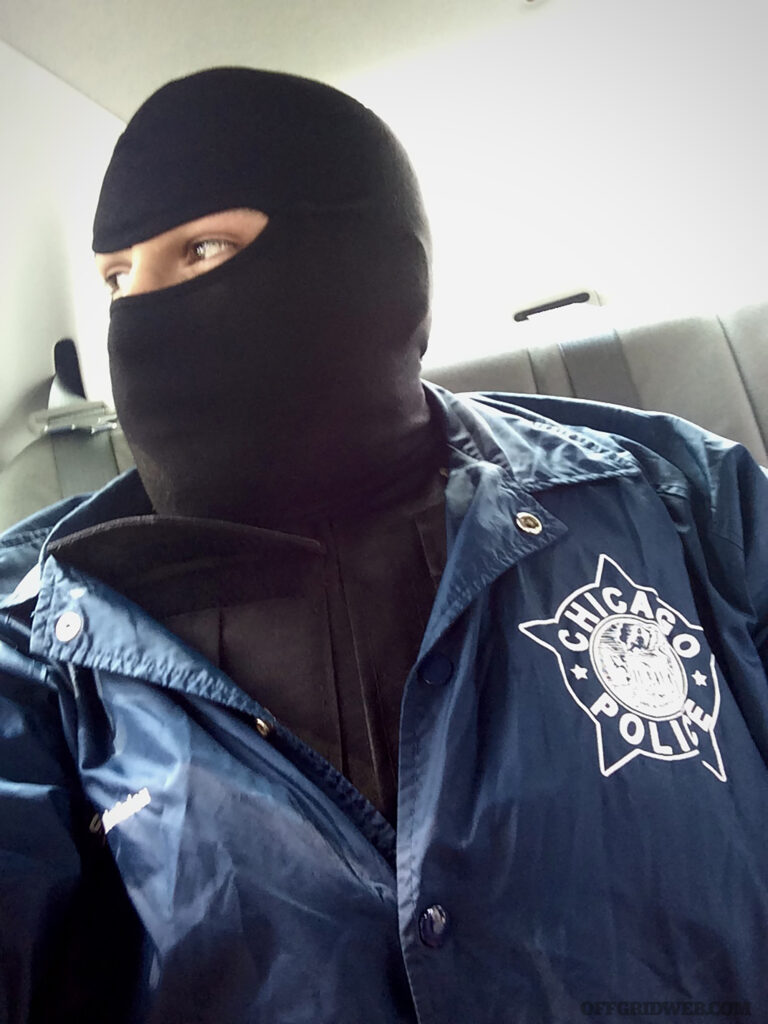
Above: Geared up and minutes away from a search warrant, tracking down a seriously bad dude. The team and I worked through the night and approached at first light. The masks were to protect our identity for continued work in the area, nothing more.
So, there I was, dressed in the well-known light blue uniform of the Chicago Police Department ready to do my part and blend my street smarts and military training to catch some actual bad dudes. I did my best to avoid creating criminals from everyday folks. I wrote more warnings than tickets and dismissed a lot of the ones that had to be written. I told more people to throw stuff away than most coppers find in their careers. There were bigger fish to fry, and time was never on our side.
I worked patrol both on foot and in vehicles, and also worked plain clothes on a tac-team. I spent time alongside some really great dudes on an undercover narcotics team — true professionals that showed me the ropes and really invested in my development. There I learned plenty about the importance of blending in and “knowing the enemy.” It was a beautiful and fine line being a good guy with the power and connections of both sides.
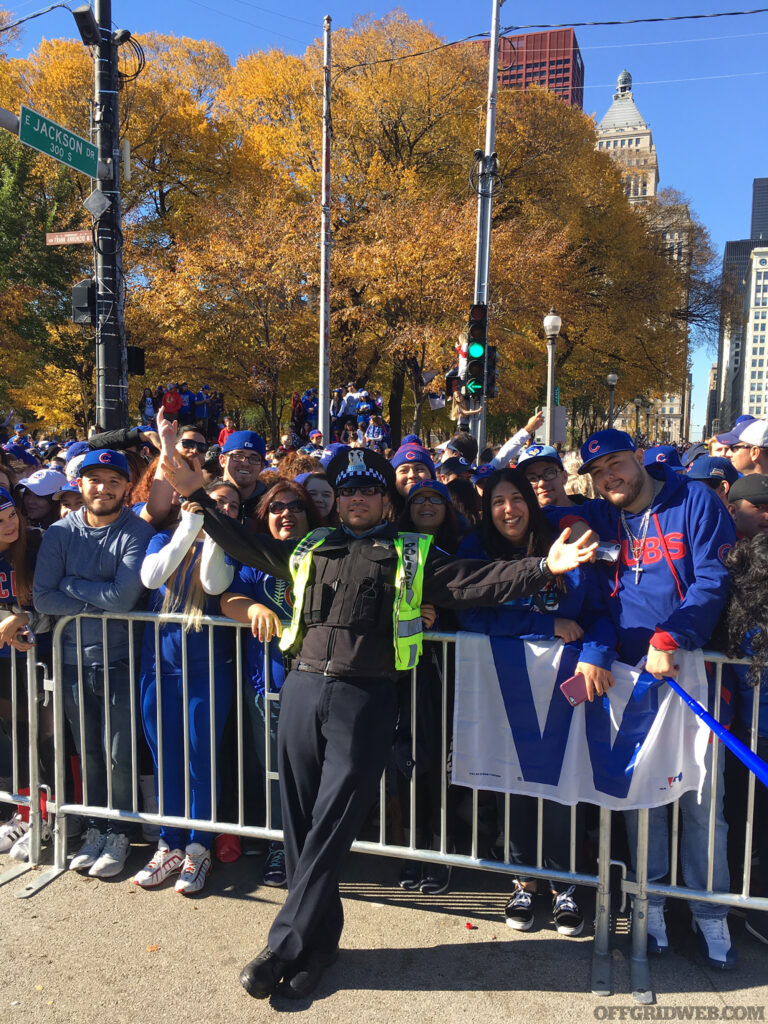
Above: Chicago Cubs victory parade. This was a huge event that called for all units to show up in uniform and crown caps.
My last stop with Chicago PD was in the firearms training unit, I was grateful for the opportunity at such an early stage in my LE career. Efcharistó, LT!
Was the gear and training you received adequate for the job you had to do? If not, what were the biggest deficiencies?
RM: The department had standard gear and training that all officers needed to have and participate in. I will say this: those of us who took the time to test our gear and seek out individual training all excelled and found ourselves on teams and specialty units sooner than some of our peers.
The biggest deficiencies were in hand-to-hand training, mostly due to the nature of more realistic/aggressive training and the potential for injury. I think you can accomplish strong and safe training if the instructors are high level coaches as well. Some positions are hard to come by, and once acquired dudes tend to stay there even if they aren’t the right fit anymore.
Honestly, we train people harder in our two-day classes than some of the training presented in the academy. It’s always possible to get good training, and I hope younger officers get their chance to make some changes. I believe in you!
How did your time as a kid on the streets prepare you for undercover work?
RM: What better teachers than those actively living and thriving in criminal lifestyles? These guys had figured some stuff out, and they were happy to share with those they trusted. Maybe this is another reason why I enjoy teaching. I had some awesome teachers, even in that phase of my life.

Above: Catching a breather after some hard sparring rounds during fight camp for the 2019 MMA fight. Local fighters Danny and Kevin were brought in to help prepare.
Time on the streets taught me about patterns of good guys, bad guys, and junkies. Fighting, running, hiding — essentially parkour before it was a thing, only with guns, drugs, and the potential of getting caught and beat up (again). I remember taking a sawed-off double barrel shotgun, its handle wrapped in duct tape, and a rusty wheel gun with electrical tape around the grip from a hidden crawl space in an abandoned building. I packed them up and carried them with a buddy to the ditch spot at Lake Michigan. Their services were no longer needed.
All of these experiences helped me better understand who I was dealing with while working in the city — creative and cunning folks on the wrong side of law. A dream I often have is that of a foot chase. I am both the one running and the one chasing. I am both young and old, running from myself, one laughing and one scowling. I awaken and think, keep running little sh*t, life is far from over!
Were there any especially dangerous situations you experienced during that time?
RM: There were plenty. Enough that even now, as I really think back, I’m flooded by memories I had stored away and haven’t visited in a while. A blend of vehicle pursuits leading to foot chases, drawing a gun and putting it back in its holster to keep moving faster. Running into buildings marked condemned and clearing rooms hastily. In retrospect, that may have been foolish, but I’m definitely happy to still be upright. Fighting to restrain someone in awkward spaces — inside of cars, housing units, and out in the open urban terrain, sometimes alone, other times with a partner. Recovering guns, drugs, and the people who possessed them.
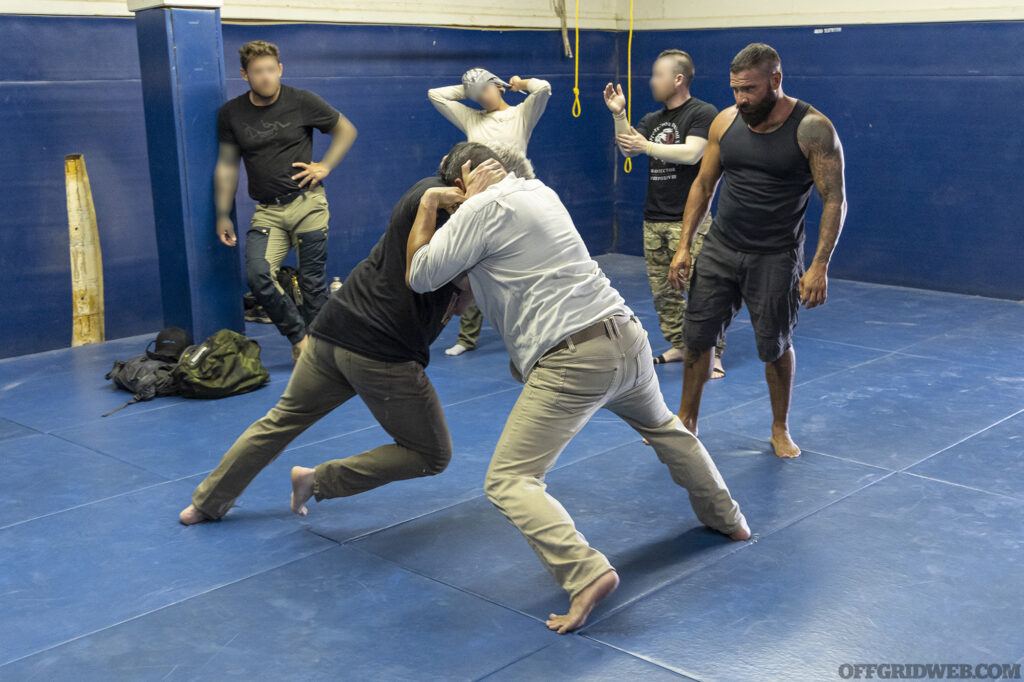
Above: Head-to-head grappling drills with students at Protector Symposium 5.0 in Tucson, Arizona.
Wrestling for control of both the individual and my own emotions. It’s an interesting switch to go from predator to protector in the blink of an eye. All these lessons were of good value, and they have made their way in the programs we teach at Rogue-Methods.com
How long have you been training in martial arts, and what styles have you studied?
RM: I was 8 or 9 when I had my first fistfight … well, more like a swinging arm session while trying to avoid being hit. We would gather around and just get after it. No one was mad about losing then, it was more of an I’ll get him next time kind of attitude.
Formal training started around age 12. I grew up in the karate and taekwondo era. In early 2000, I started Brazilian jiu jitsu, Krav Maga, wrestling, boxing, and catch wrestling. MMA came to me later in life, though it made sense having trained for so many years. It was an amazing experience training and preparing for a fight.
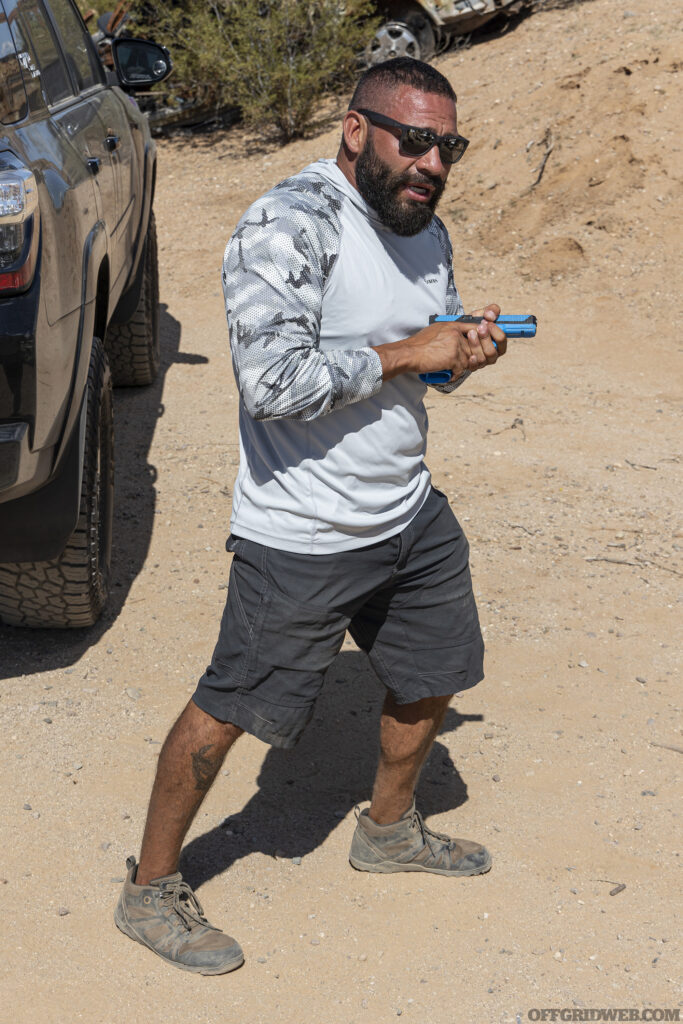
Above: Demonstrating an “off-body holster” method to protect and control a firearm if you realize a hands-on fight is imminent.
I carry those lessons with me daily. I continue to seek out seminars on guns and knives. It’s been a lifetime of curiosity, which has yet to fade. I constantly seek out coaches that I find interesting and try my best to keep active and ready to fight. One of the best coaches I’ve had is Ryan Hoover of Fit to Fight. Check him out when you have a chance.
When did you start working full-time as an instructor? We recall you were the director of training at Fieldcraft Survival for a while, and then branched out to start your own company, Rogue Methods.
RM: I had never heard of Fieldcraft or its owner until I met them in Prescott, Arizona, back in 2018. When we met, we sat down and had a couple of long conversations. We chatted about goals for the future of the training department. It was two classes a month then. When I was entrusted with its growth, I took them from two classes to about 14 to 16 a month. We had multiple classes in multiple states happening every weekend. It was a huge success, and I attribute it to the team I had built. This was a very valuable experience for me, one I’m grateful for having and ending on my terms.
The rise of Rogue Methods came to fill in a missing element in the training space. An idea of empowering others — from novices to professionals — in a blended style of hand-to-hand combat training and the tools we all carry for self-defense. Similar training already existed; this was just my take on how to do it best.
Every program we offer has a medical and a self-defense component, even if it is a shooting specific class. That was something I noticed was missing in the training I had seen. The true challenge was in making sure we could transfer as much retainable information as possible in our one- and two-day courses. I embraced the task of cutting out the unnecessary fluff that I was tired of hearing and seeing in some presentations. (More on this in my favorite quote section of the article.)
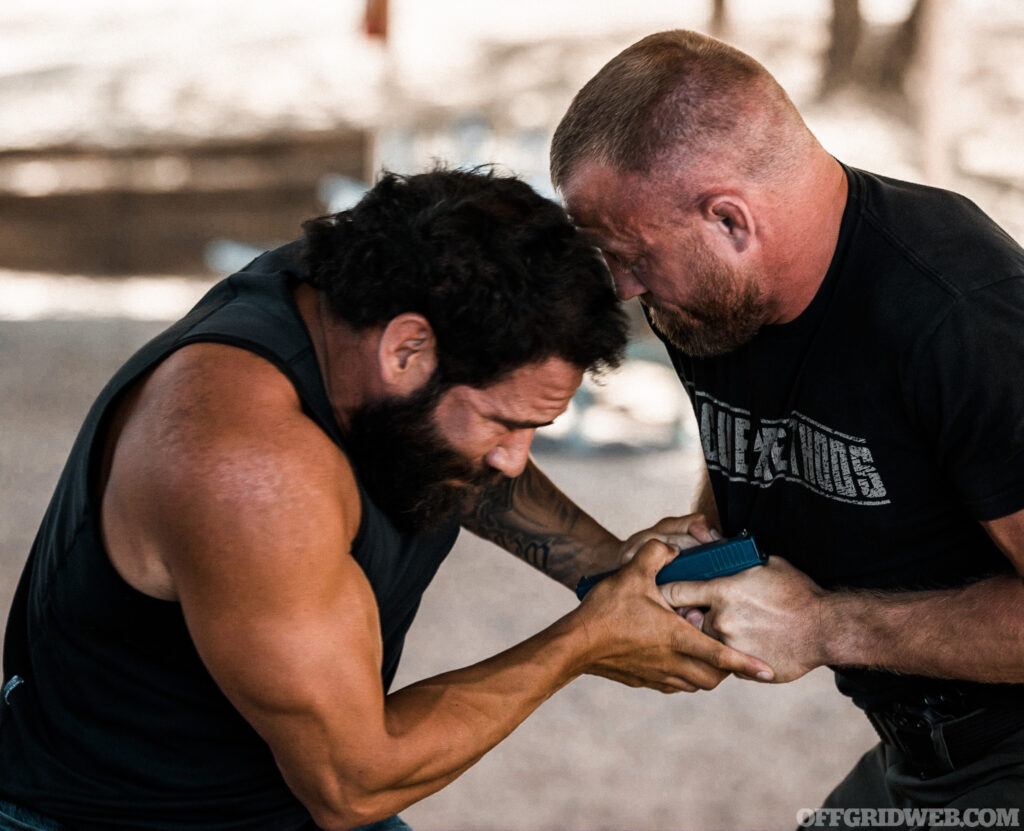
Above: Raul and Rogue Methods Coach Dan M. demonstrating one of several gun retention techniques from outside the holster during a Close Contact Gunfighter class.
Rogue Methods training is an experience like no other, and it belongs to you the moment you leave, and then return again, as most of our folks do. The training helps you connect ideas to your physical body and helps you understand your capabilities. Does it require you to invest in yourself? Absolutely. Why wouldn’t you, especially now that you understand that a little time and practice can go a long way to maintain your safety and the safety of those around you. Be it in the form of awareness or the ability to handle a confrontation, you’ll be better equipped to make these decisions for yourself.
Shout out to my team for their professionalism and dedication to the work that we do daily for our fight tribe/legion. Dan R., Dan M., Hunter C., Dillon V., Mark O., and Joel M., you guys rock!
Based on our time training with you, you’ve got a unique approach to blending hand-to-hand skills and shooting skills. How likely is someone to need both in a real self-defense situation?
RM: Hopefully you’ll never find yourself in a situation requiring you to use any of the skills you learn with us. Though if you do find yourself having to go hands-on someday, and it escalates to a firearm or a knife, then at least you have a reference file to tap into.
We train in medical, striking, defense, and offense. Weapons retention and recovery, force on force, and the de-escalation of it all in live practice. Look, most situations can and should be avoided by taking the high road if possible.
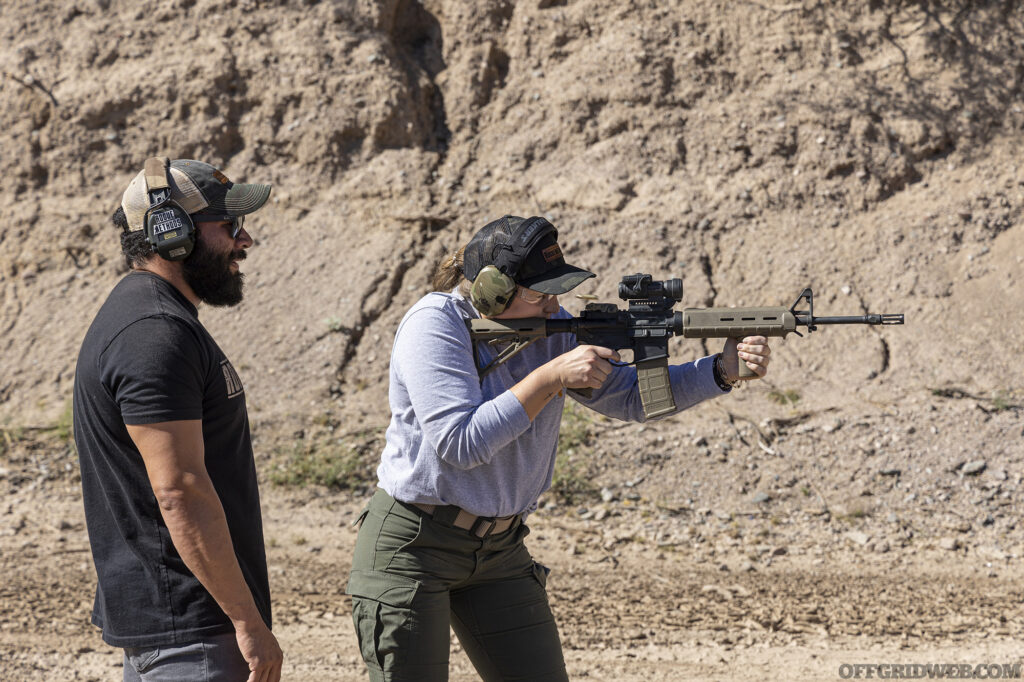
Above: Observing a student to provide feedback during a Low Profile Carbine class in Phoenix, Arizona.
There are folks who chose this lifestyle as a profession, and I’ll always be grateful for my brothers and sisters in blue — thank you for doing what you do and for keeping our communities as safe as possible. I know better than most about the limitations that are imposed on you by both command staff and the media. Keep up the good work.
How does your Close Contact Gunfighter curriculum differ from a traditional shooting class?
RM: The Close Contact Gunfighter program focuses more on building fighting skills. There is some shooting in the class, though it’s mostly to drive confidence in key fighting skills such as shooting one handed and moving while shooting.
I believe this class has a lot to offer participants — everything from team building to medical, striking, wrestling, knife defense and offense, shooting, gun retention and recovery, reality-based scenarios, force-on-force training, and hours of strong repetition. It’s an overall great experience for everyone.
The feedback and reviews from folks who have trained with us has been positive and motivating. This class is truly one of a kind.
We imagine you encounter some students with a lot of shooting experience but minimal martial arts experience, and others with the opposite. What “training scars” does each extreme create, and how do you overcome them?
RM: We do often see the disparity in skills from tools to hands-on abilities. Unless you’re in the military or law enforcement, there are limited training options for folks who carry. Again, a major reason we’re so proud and honored to be able to share the Close Contact Gunfighter program with everyone.
On the shooter’s side we’ll notice an over-dependence on the gun for all things defense. On the martial arts side, we see an overwhelming emphasis on controlling the person and losing the tools, be it a gun or a knife. Close Contact Gunfighter helps you find and balance both to your benefit.
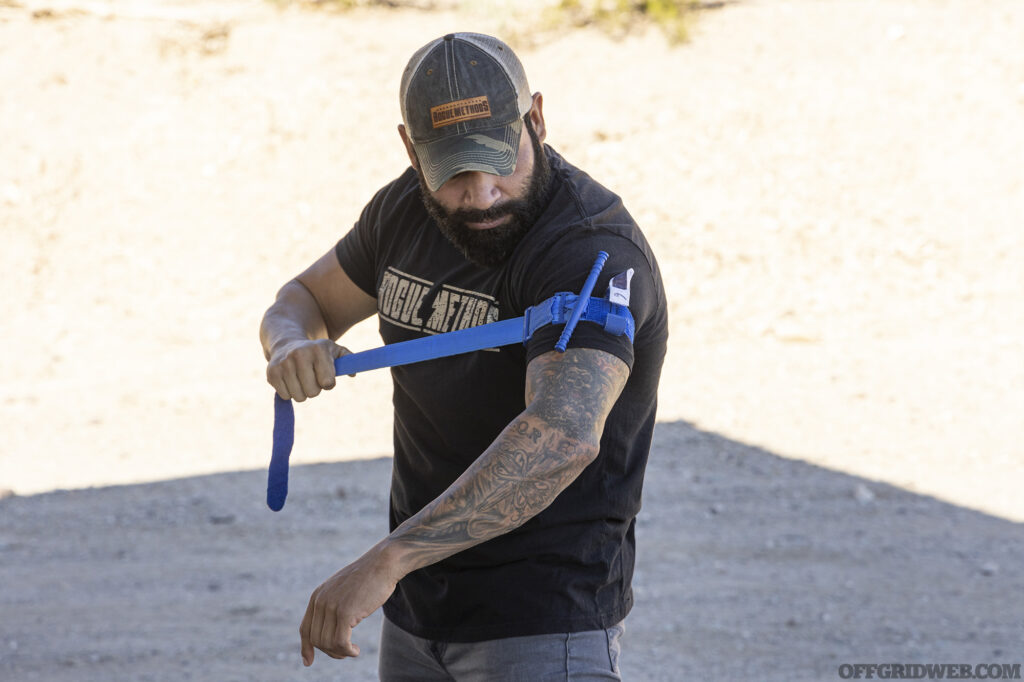
Above: Self-applying a tourniquet. All Rogue Methods classes incorporate an element of first aid training, since Raul believes it’s an essential skill for anyone who expects to survive a fight.
The class is based on small group training. No more than 14 people, so I am able to customize most of the class to help individual needs. Training scars and all are broken down, and new habits start to form. We receive so much feedback about how the class has motivated folks to continue to train on their own. I’m grateful to be a coach and friend to all those who have trained with us, and I look forward to meeting and training with those of you who are reading this now.
Your personal pistol and carbine setups are both pretty minimalist by today’s standards. What’s your reason for keeping it simple?
RM: They are pretty bare-bones, now that you mention it. Training has always been a priority for me over gadgets and gear. What and how I carry is based on how I have experienced the environments I lived and worked in.
Simple works. Iron sights work. A strong retention holster and a solid sling will help you keep your gear from getting taken. A handheld flashlight and a good blade will save you in a pinch. Rely on your hands and your wits but know that doing so requires you to focus on strengthening your physical abilities.
The gear you carry should simply be an extension of your capabilities, not the reason for them.
People are awesome, they just need to be reminded sometimes, so here it is. Go train your body and then add in the tools. You’ll quickly see how useful and simple it all becomes. Trust and believe in yourself!
If there’s one lesson you could teach everyone in America about self-defense, what would it be?
RM: If you haven’t started training in some form of contact sport, start now. Wrestling, boxing, BJJ, kickboxing — get a heavy bag and go to town on it. Find some training partners and play around. Anything where you’re working with a living, breathing, and thinking training partner goes a long way. This will help you fast-track your learning, although there is no shortcut to fighting and fight training. Some good coaching and the right stimulus will help move things along faster. That’s why I’m proud of my team, programs, and company. We have a formula that helps people get better the moment they decide they want it.
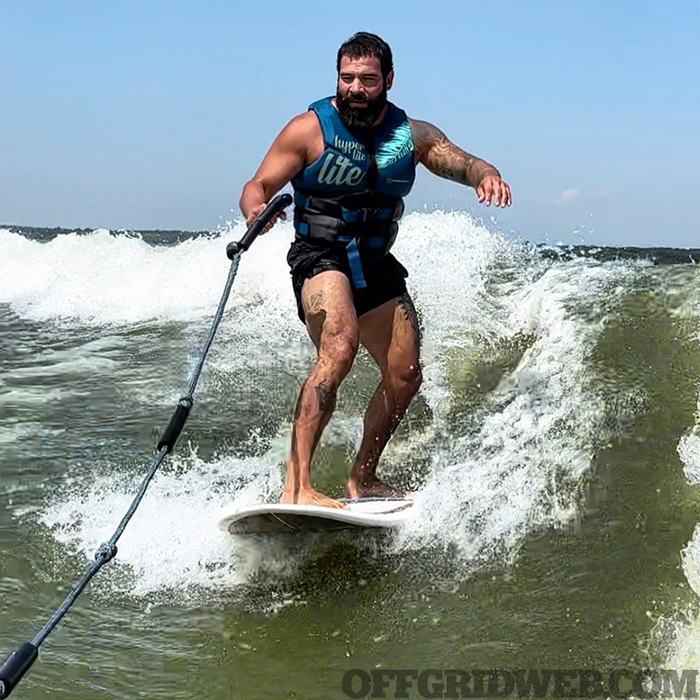
Above: Just living a healthy life and continuing to add new skills. Lake surfing in Dallas, Texas, with some awesome friends.
Raul's EDC Gear
- S&W J-Frame Model 442 revolver
- Cor-Bon Pow’RBall .38 Special ammo
- HeadHunter Blades “The Rat” knife
- Ray-Ban Justin shades
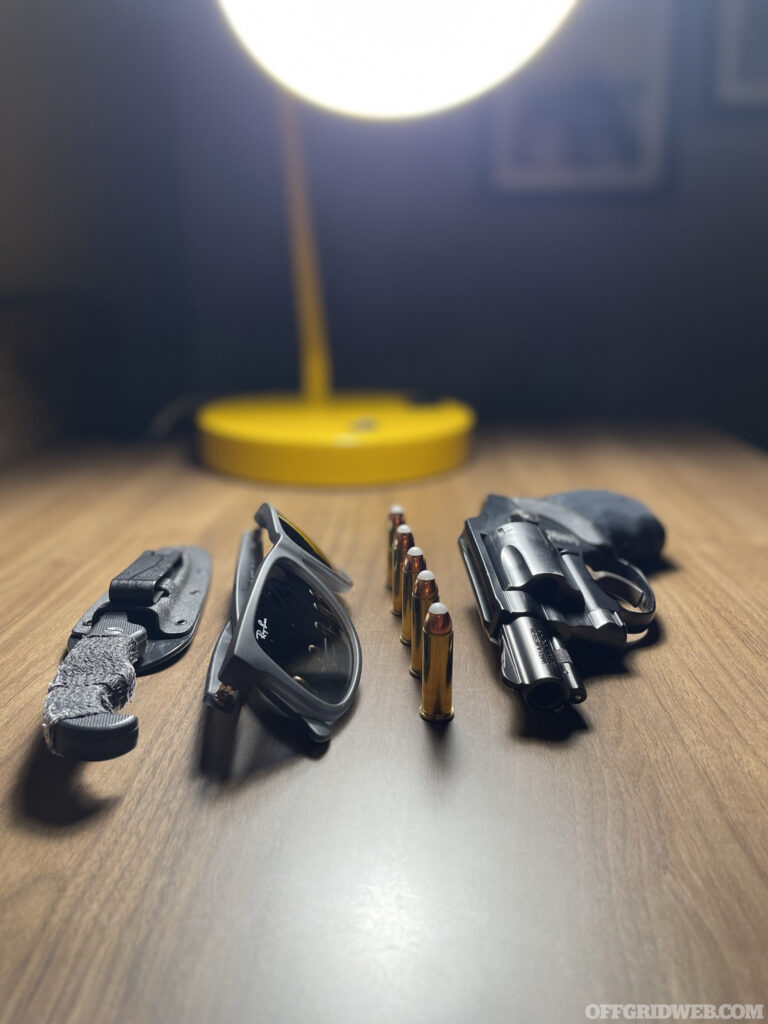
About Raul Martinez
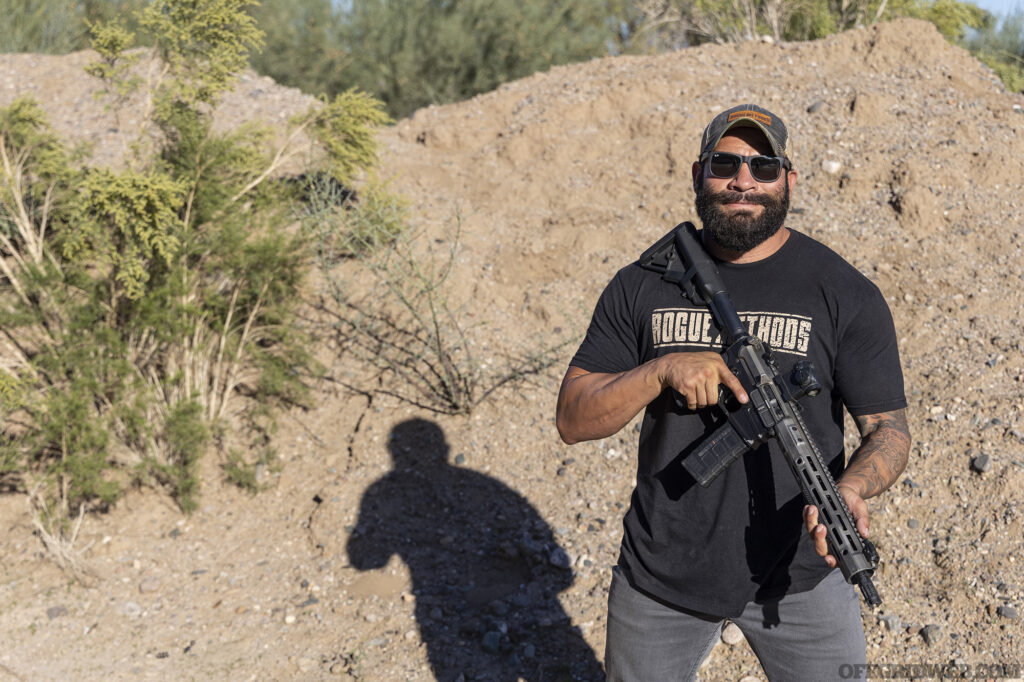
Age: 40
Hometown: Chicago, IL
Family & Pets:
A loving and patient mother; a stern yet fair father; seven brothers and sisters; fantastic aunts, uncles, and cousins; a most gorgeous and inspiring wife; six kids; and two dogs that resemble their owner’s build — short and stocky. I love you all!
People Who Inspire Me:
Christ Almighty, my grandfather, all the people taking action and becoming the leaders they were meant to be (keep going!)
Favorite Movies:
Gladiator, Fight Club, The King, The Passion of the Christ, Braveheart, King Arthur (Antoine Fuqua)
Favorite Quote:
“They muddy the water, to make it seem deep,” – Nietzsche. It applies to so many aspects of life. People tend to complicate simple things in an attempt to make themselves seem more important. You’re never more important than the people you serve.
Favorite Places to Eat in Chicago:
Tacos: Atotonilco in Little Village, fantastic al pastor and steak tacos
Pizza: Villa Palermo in Rogers Park, an old-school Chicago pizza joint
Recommended Reading:
- The Reader’s Digest Bible
- Breathe: A Life in Flow by Rickson Gracie
- 48 Laws of Power by Robert Greene
- The Tao of Jeet Kune Do by Bruce Lee
- To Ride, Shoot Straight, and Speak the Truth by Jeff Cooper
URL: rogue-methods.com
Instagram: @rogue.methods
Related Posts
The post Raul Martinez Jr. Spotlight: Rogue Methods appeared first on RECOIL OFFGRID.
By: Patrick Diedrich
Title: Raul Martinez Jr. Spotlight: Rogue Methods
Sourced From: www.offgridweb.com/preparation/raul-martinez-jr-spotlight-rogue-methods/
Published Date: Sat, 19 Aug 2023 11:00:31 +0000
------------------------
Did you miss our previous article...
https://bushcrafttips.com/bushcraft-news/homemade-bug-out-vehicles-and-how-to-build-yours
 What is BushcraftSurvival SkillsToolsVideosBushcraft CampsBushcraft KitsBushcraft ProjectsPrivacy PolicyTerms And Conditions
What is BushcraftSurvival SkillsToolsVideosBushcraft CampsBushcraft KitsBushcraft ProjectsPrivacy PolicyTerms And Conditions
